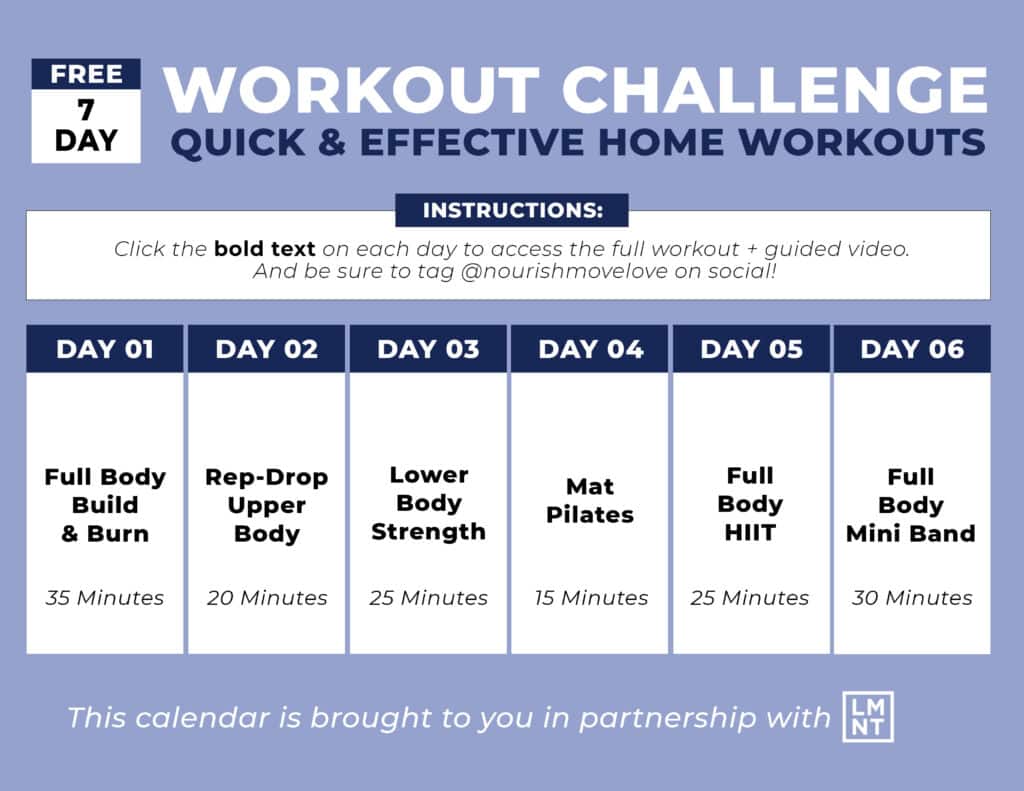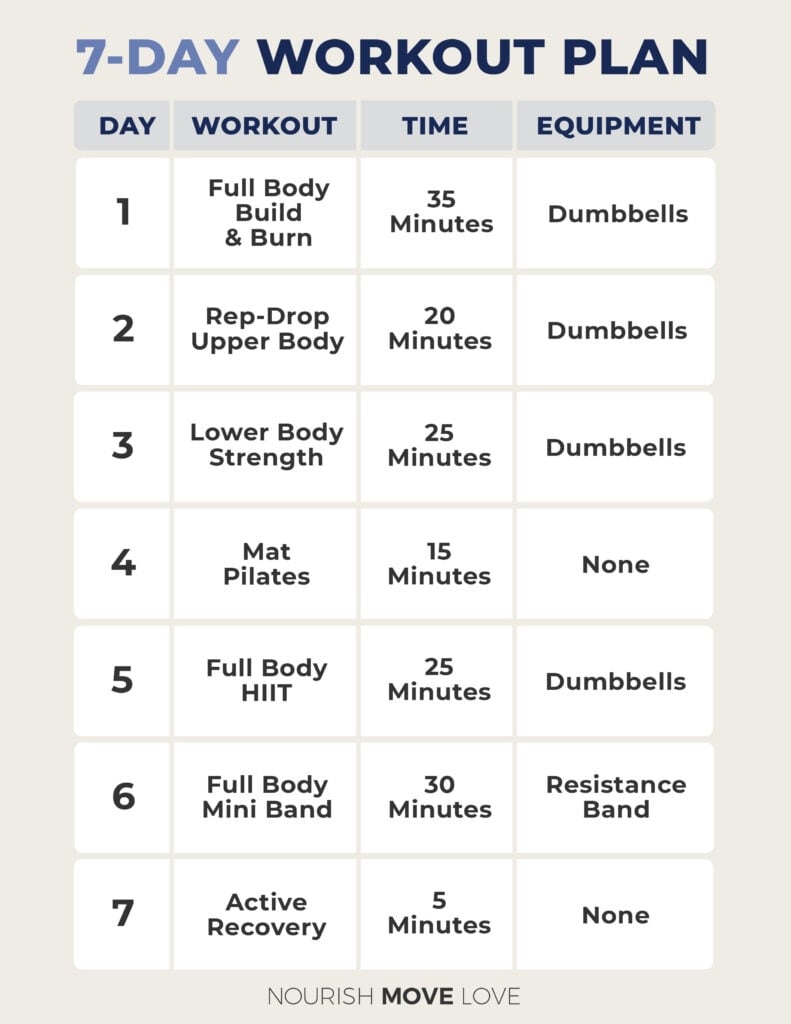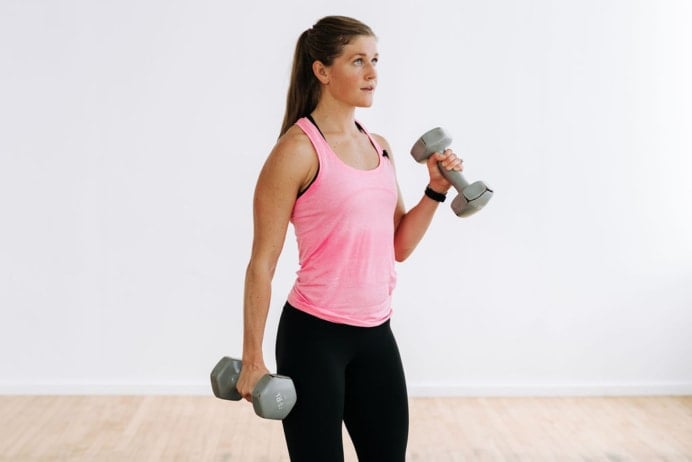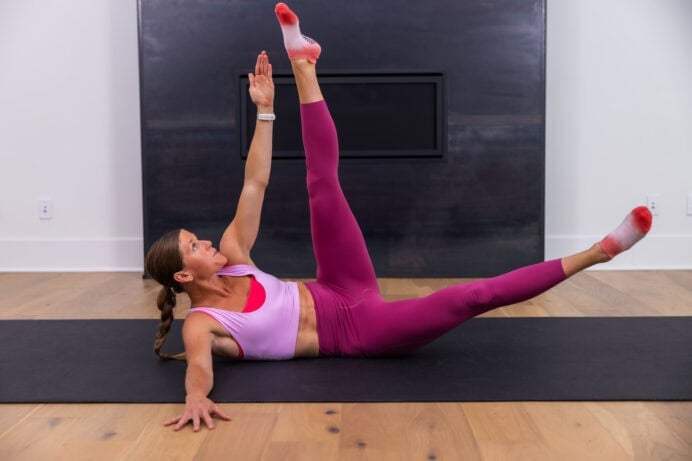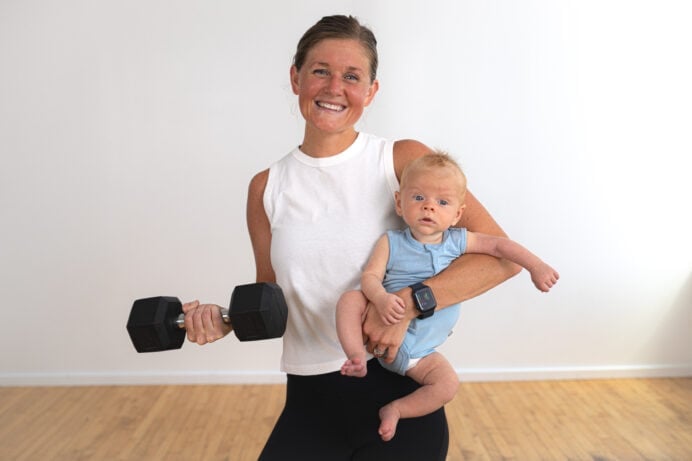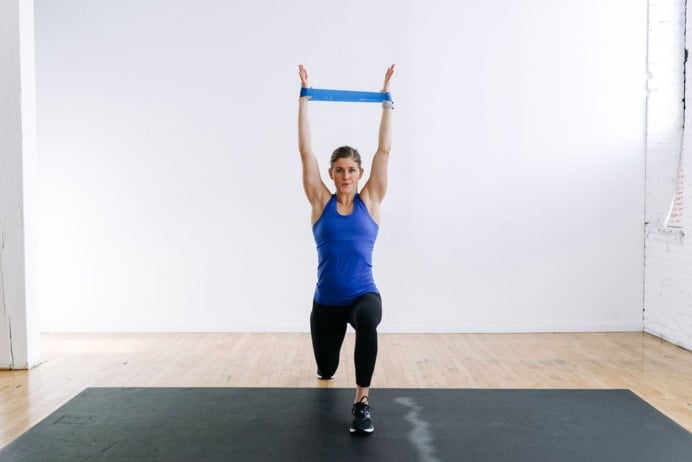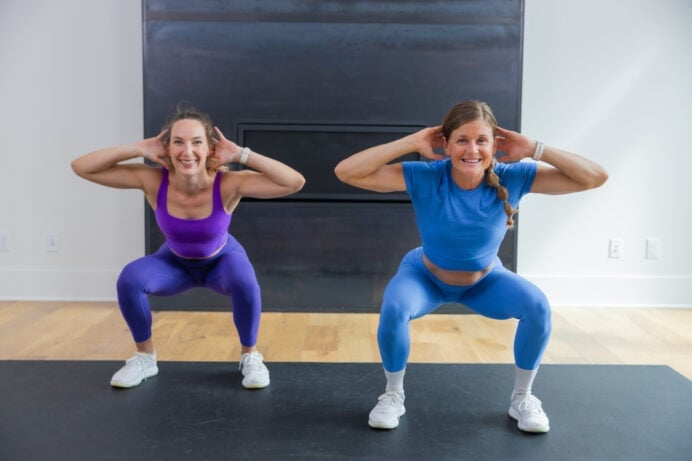
Weekly Workout Schedule for Women
If you’re looking for a simple, effective weekly workout schedule that fits into your busy life, this 7-day at-home program was made for you. Designed by a certified personal trainer and mom of 3, it combines strength training and HIIT to help you build muscle, burn fat and boost your energy – all with minimal equipment and maximum results. With a clear schedule and balanced structure, this plan takes out the guesswork so you can stay consistent, feel stronger and finally create a routine that sticks.
Quick Links:
When life gets busy, the last thing I want is to waste time trying to figure out what workout to do. That’s why having a written schedule makes such a difference for me – it takes all the guesswork out. When I know exactly what I’m doing each day, it’s so much easier to stay consistent. A clear plan saves time, reduces stress and helps me stick with it so I can feel stronger, healthier and more in control.
Establishing a consistent weekly workout routine has been one of the most important things I’ve done for both my physical and mental wellness. It helps me stay disciplined and build lasting habits. Regular strength training has improved my posture, joint health and bone density, while cardio boosts my endurance and heart health. When I combine the two on a regular basis, I feel better in every part of my life, not just in the gym, but in how I move and function day to day.
My weekly routine typically includes strength training 2-4 times per week, cardio 2-3 times, and at least 1 active rest or mobility-focused day. That’s exactly what I’ve built into this workout plan. It targets all major muscle groups with a mix of upper-body, lower-body and full-body training days. I’ve included weight lifting and high-intensity cardio to create a functional, effective plan that will help you build lean muscle, boost your metabolism, support fat loss and improve your cardiovascular fitness.
The structure of this plan reflects some of the training principles I’ve found really helpful, like the 3-3-3 rule (3 sets, 3 exercises, 3 times a week for beginners) and the 4-2-1 rule (4 moderate workouts, 2 high-intensity days and 1 recovery day). These formats give me just the right amount of structure without making things overly complicated.
At the end of the day, the best workout schedule is one that aligns with your goals, fits into your life and challenges your body without burning you out. This plan is designed to promote progressive overload, which has helped me build a strong foundation for functional fitness. So I’m not just working out for the sake of it, but training to feel better in everyday life.
Whether you’re just getting started or looking to reestablish an exercise routine, this 7-day program gives you the structure, variety and flexibility you need to stay consistent and see real, lasting results. When paired with proper nutrition and hydration – especially a high-protein diet to support muscle recovery – you’ll feel stronger, healthier and more in control of your fitness journey.
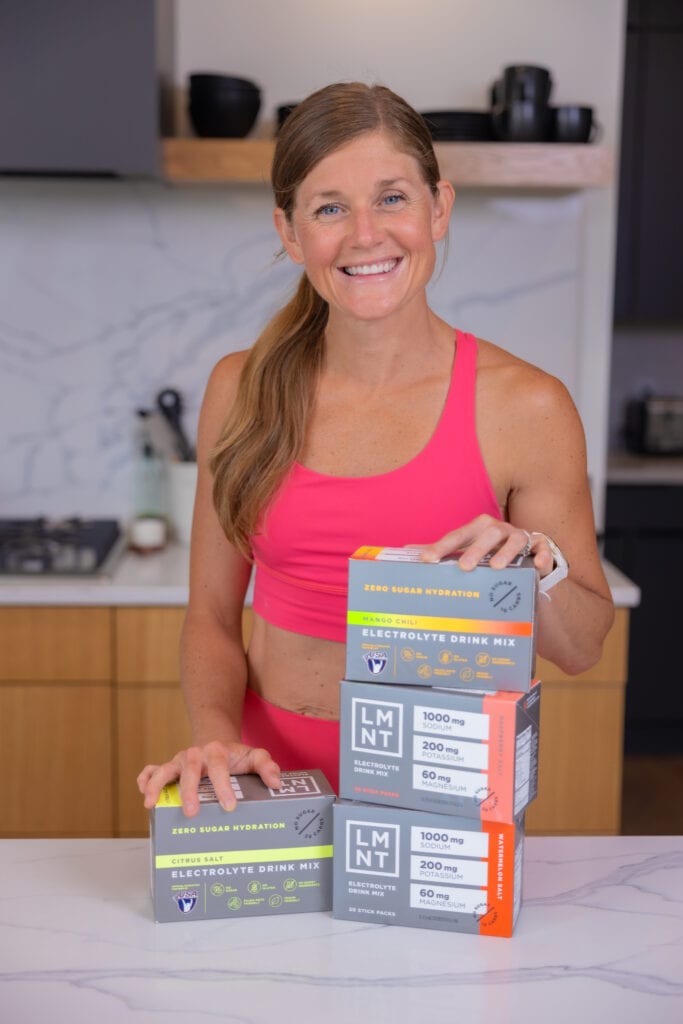
My Go-To Electrolyte
Click the link below to get a free 8-count sample pack of LMNT’s most popular drink mix flavors with any purchase.
This Plan Is Ideal For
- Individuals aiming to build strength across all major muscle groups, including the upper-body, lower-body and core.
- People looking to build the strength to properly perform strength exercises like Romanian deadlifts, lunges, leg extensions, calf raises, lateral raises, skull crushers, tricep extensions, shoulder presses, push-ups, pull-ups, bicep curls, lat pulldowns and crunches.
- Those looking to elevate their heart rate and boost cardiovascular endurance through dynamic training.
- People seeking to enhance core strength, flexibility, balance and overall mobility.
- Anyone interested in combining strength training with high-intensity cardio for a well-rounded workout.
- Individuals looking to burn calories, lose weight and reduce body fat all from the comfort of home.
- Those wanting to establish a consistent, effective at-home fitness routine in just one week.
- Beginners or returning exercisers ready to kickstart a healthier lifestyle with guided, structured workouts.
Modifications are offered in each of the daily workouts to make this workout plan accessible for any fitness level. If you’re a beginner, you can build muscle by focusing on bodyweight exercises and light weights. I’d recommend starting with my beginner workout plan and progressing to a more advanced split training workout plan. If you need modifications for pregnancy or postpartum, check out my pregnancy and postpartum workout plans.
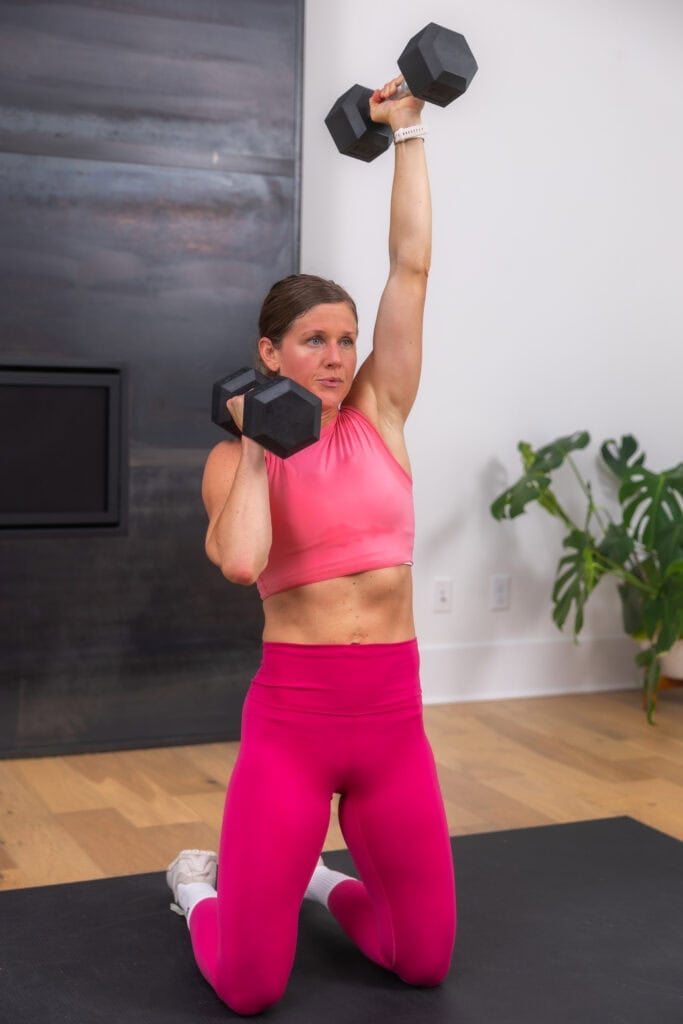
LET’S GET STARTED
Download Your FREE Workout Plan Here
Weekly Workout Plan
Day 1: 35-Minute Full-Body Strength and Conditioning Workout
- Workout Time: 35 Minutes
- Equipment: Dumbbells
Day 2: 20-Minute Quick Arm Workout
- Workout Time: 20 Minutes
- Equipment: Dumbbells
Day 3: 25-Minute Dumbbell Leg Workout
- Workout Time: 25 Minutes
- Equipment: Dumbbells
Day 4: 15-Minute Mat Pilates
- Workout Time: 15 Minutes
- Equipment: None
Day 5: 25-Minute Full-Body HIIT Workout
- Workout Time: 25 Minutes
- Equipment: Dumbbells
Day 6: 30-Minute Full-Body Resistance Band Workout
- Workout Time: 30 Minutes
- Equipment: Mini Loop Resistance Band
Day 7: 5-Minute Daily Mobility
- Workout Time: 5 Minutes
- Equipment: None

Find This Workout Plan On YouTube
Week-Long Workout Schedule Details
1. Gym Equipment Needed:
A Set of Dumbbells. Most of the daily workouts require a set of dumbbells. Each weight training workout will have a recommended dumbbell weight, usually between 8-20 pounds. You want a weight heavy enough that your last few reps are a struggle, but you are still able to complete the workout with good form. Shop my dumbbells here (Discount Code: NML5).
Optional Exercise Equipment:
Mini Loop Resistance Band (Discount Code: NML)
2. Time Requirement:
Workouts are 15-30 minutes a day, 6 days per week. You can always take more rest days as needed. Each workout includes a dynamic warm-up and a dedicated cool-down to prevent muscle soreness.
If you’re reducing workout days to accommodate a running schedule or make this plan beginner-friendly, I recommend completing 2-3 of the strength workouts per week.
3. Fitness Level:
Intermediate to advanced, with modifications offered for all fitness levels in the daily workout videos.
If you’re looking for a full-body workout plan for beginners, follow my Beginner Workout Plan.
4. Cost:
FREE! No sign up needed, this is a FREE Workout Plan.
FAQs
Ultimately, how much cardio you should do each week depends on your fitness goals. If you’re training for a specific race or working to improve your endurance, you might need to do more cardio than someone who is focused on strength training to build muscle. A general guideline is to aim for about 150 minutes of moderate-intensity cardio each week. You can break this up however works best for you. For example, you could do 30 minutes of moderate cardio 5 days a week.
Beginners who want to build muscle mass should focus on a combination of resistance training, a high-protein diet and rest. Start by focusing on compound exercises like squats, deadlifts and bench presses. These movements work multiple muscle groups at once. You can use either free weights or machines to get started. Aim for about 2-3 workouts per week, making sure you’re hitting all your major muscle groups during these sessions.
You’ll need to eat enough protein and calories to fuel muscle growth. Letting your body recover is just as important as the workout. Give your muscles enough time to rest between training sessions.
As a beginner, the best way to start a gym workout is to focus on form. Don’t worry about lifting super heavy or completing long workouts. Start with a few days a week, making sure to mix in some cardio and strength training. I recommend following a well-rounded plan for accountability and motivation. A well-rounded workout plan will hit every muscle group (total-body, upper-body and lower-body) and include strength training, cardio workouts and mobility.
The 6-12-25 rule involves performing 3 sets of exercises with different repetition ranges: 6, 12 and 25. This dumbbell training method challenges muscles in different ways, promoting both hypertrophy (muscle growth) and endurance. Ideally, you perform 6 repetitions of a compound exercise with a heavy weight, 12 repetitions of an accessory exercise at a moderate weight and 25 repetitions of an accessory exercise at a light weight.
How to Download and Use This Weekly Workout Plan
- Download the Weekly Workout Schedule PDF by clicking here, or bookmark this webpage for reference.
- Save this workout calendar to your iPhone home screen for easy access.
- Open this workout calendar pdf in the Safari browser on your phone.
- Tap the bottom arrow in the center of your screen.
- Select ‘Add to Home Screen’.
- Hover over and then click on the bold text each day to access the full-length, real-time workout video on nourishmovelove.com. Or scroll to find the daily workouts on YouTube here.
- You can also access all of the home workout videos on this workout challenge calendar on YouTube via this YouTube Playlist: Weekly Workout Schedule for Women.
- Share your daily workouts with me by tagging @nourishmovelove on social and ‘Pin’ the daily workouts on Pinterest so you can do them again.
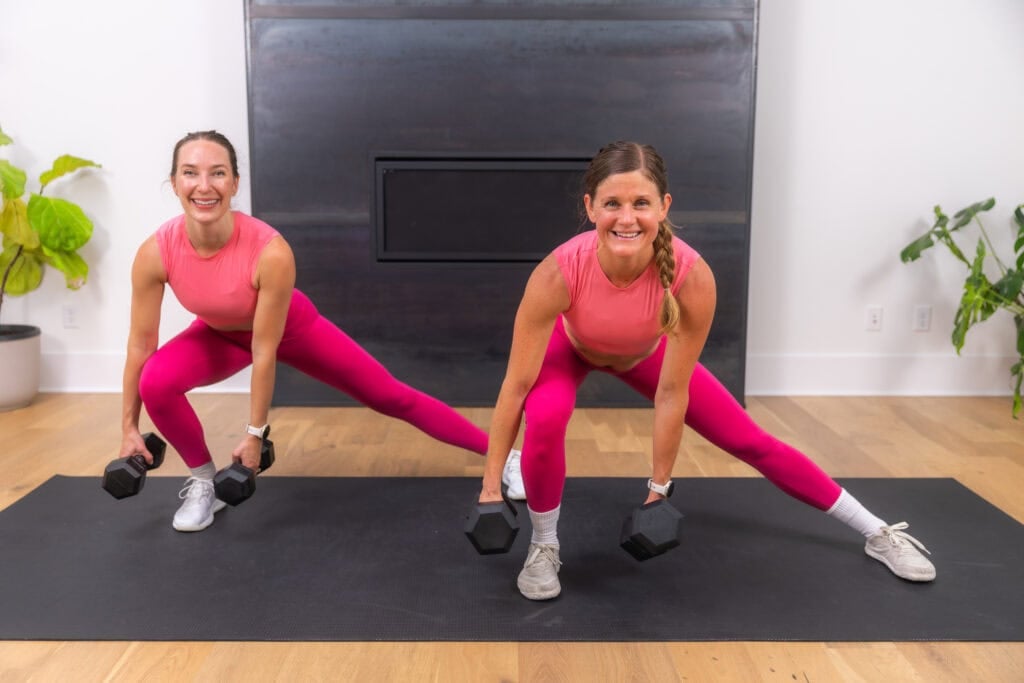

Get My Full Program Guide!
Pin This Weekly Workout Plan for Women
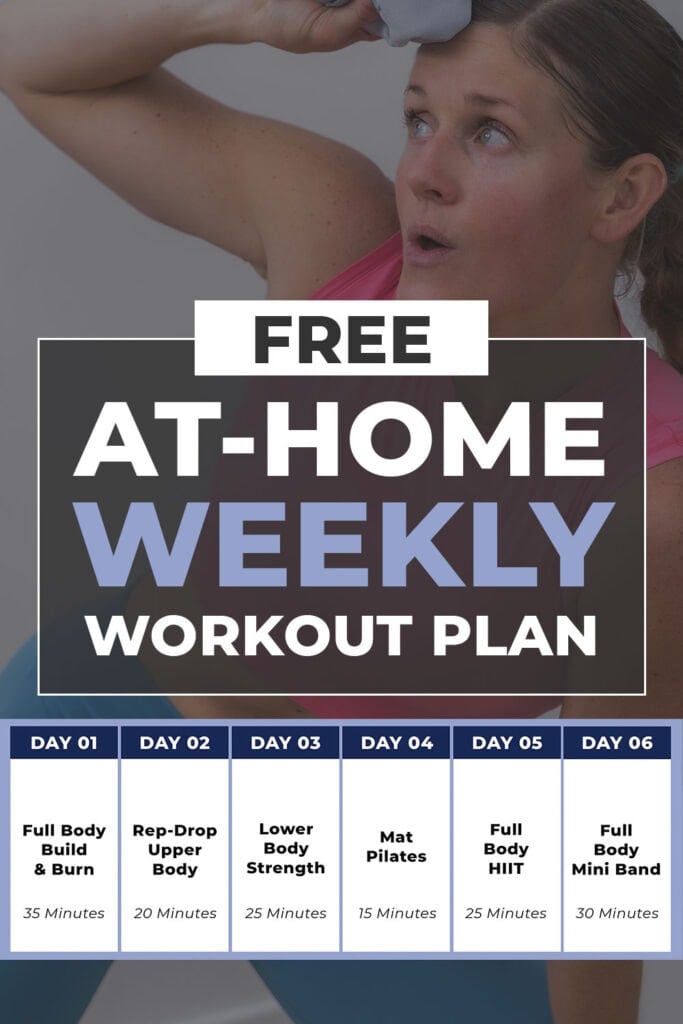
Note: Before beginning any new exercise program you should consult with your physician or midwife. The information provided with this workout challenge is intended for general information and use; it does not include specific, individualized recommendations and is not intended as medical advice. Before you begin any new exercise program Nourish Move Love, LLC recommends that you consult with your physician. Nourish Move Love, LLC primarily educates clients to assume more personal responsibility for their health by adopting a healthy and active lifestyle.
This post is sponsored by LMNT. All opinions are my own. This post includes affiliate links. I do make a small commission for products purchased using these links (at no additional cost to you). Thank you for supporting Nourish Move Love, making the content you see on this blog possible.










